The Stephen Petronio Company performs a new Petronio work at the Joyce and remounts Merce Cunningham’s “RainForest.”
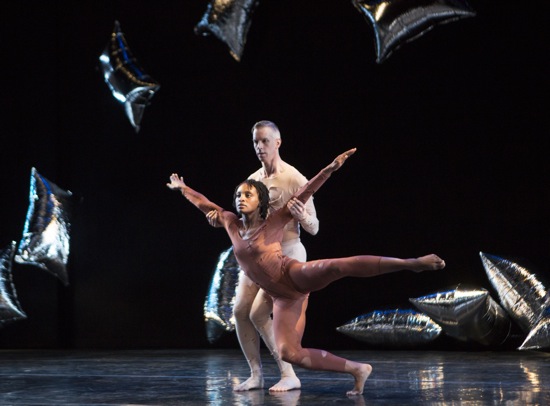
Merce Cunningham’s RainForest: Andy Warhol’s silver pillows share the stage with Davalois Fearon and Gino Grenek of the Stephen Petronio Company. Photo: Yi-Chun Wu
Decades ago, when Twyla Tharp was a feisty young choreographer, she said that maintaining and presenting dances from her repertory was just not something she wanted to do. It would be like chewing gum, she said, and who wanted to keep on chewing it after the initial flavor was gone? The brilliant upstarts of Judson Dance Theater in the 1960’s were also keen on the next thing to try, not interested in reviving last year’s creation.
Now thoughts of heritage and history are in the air. Preservation and innovation duke it out in the Martha Graham Dance Company. The José Limón Company searches for contemporary dancemakers whose works might fit the company profile, even as it revives Passacaglia by Limón’s mentor Doris Humphrey and performs it onstage alongside pieces by Paul Taylor during the Taylor company’s recent Lincoln Center season, as part of an entity titled Paul Taylor’s American Modern Dance. In accord with Merce Cunningham’s wishes, his company dissolved two years after his death. Now his dances are being judiciously scattered among other companies. Just this spring, I have seen Compagnie CNDC-Anger, perform a Cunningham “Event,” directed by the French company’s director, Robert Swinston (https://www.artsjournal.com/dancebeat/2015/03/the-merce-resurrection/). Another former Cunningham dancer, Rashaun Mitchell, assembled an Event out of material from Cunningham pieces familiar to him for New York University-Tisch School of the Arts’ Second Avenue Dance Company. Still another, Jennifer Goggins, staged Biped for the spring performances of Juilliard Dance (https://www.artsjournal.com/dancebeat/2015/04/juilliard-dance-tackles-masterworks/).
And this week, at the Joyce, the Stephen Petronio Company is performing Cunningham’s RainForest, staged by Andrea Weber, with assistance from Meg Harper and Mitchell (all alumni of Cunningham’s company). What’s going on here? Petronio recently turned 59 and looks to be in excellent shape, so he can’t be thinking of his company’s future without him. Instead, the mounting of this 1968 Cunningham work is part of a project that he labels “Bloodlines,” and over the next five years, he plans to present work by Trisha Brown, in whose company he danced, as well ones by Lucinda Childs, Yvonne Rainer, and Steve Paxton (he already, in 2012, performed Paxton’s solo Intravenous Lecture). In other words, he’s generously acknowledging his own roots, along with the legacy of innovation in modern dance that Cunningham instigated.
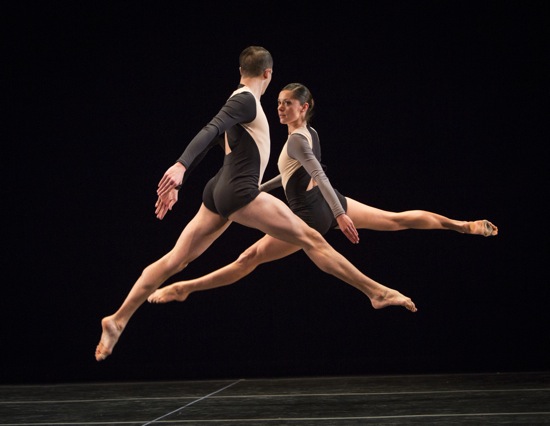
Joshua Tuason and Melissa Toogood pass each other in the first part of Stephen Petronio’s Locomotor/Non Locomotor. Photo: Yi-Chun Wu
The RainForest revival ends a program that begins with Petronio’s Locomotor/Non Locomotor, a 55-minute pairing of the 2014 Locomotor with its world-premiere cousin, Non Locomotor, The earlier piece, which celebrated his company’s 30th-anniversary season, has become richer and deeper during its year-long ageing process. Special guest artist Melissa Toogood (another former member of the Merce Cunningham Dance Company) is even more extraordinary in her opening solo than she was last year. She begins in low light (by Kenneth Tabachnick) and silence. She makes the complex movements that Petronio has cast onto her body look like daily-life activities in a concrete jungle. She bends her torso extravagantly, often in seeming opposition to her hips or her head; her legs whip smoothly about, and so do her arms. Yet, she makes everything cohere into a serious, fluent physical monologue and can rein herself instantly into watchful stillness before erupting into the next bout of dancing. Often she suspends a difficult moment, as if taking a breath before plunging on.
When I wrote about Locomotor last April, I used the word “tracks” to describe the eight dancers’ many forays onto the stage and off and back on again (https://www.artsjournal.com/dancebeat/2014/04/family-ties/). But that term suggests the straight lines of a railroad, and what we see are most often curving paths that suggest cyclical progressions. Petronio has mentioned the twinned ideas of looking backward to one’s history and forward to an unforeseeable future. As the score by Clams Casino (Michael Volpe) begins with an initially quiet jangling, Joshua Tuason walks onto the stage backward. By the time the sounds have escalated to something like tolling bells, the dance has established itself as an exacting but exhilarating voyage for a group of pilgrims who are strong of spirit, skill, and endurance. Scratch “pilgrims;” call them heroes—their bodies and souls firmed into beauty. The music may suggest a chuffing engine, cracking whips, slow chords, buried voices, rhythmic thuds, and more, but the dancers are unfazed; their wheels are greased.
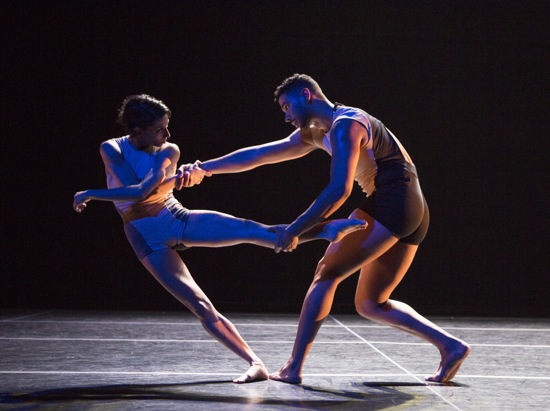
Jaqlin Medlock and Barrington Hinds in Stephen Petronio’s Locomotor/Non Locomotor. Photo: Yi-Chun Wu
Toogood, Tuason, Davalois Fearon, Gino Grenek, Barrington Hinds, Jaqlin Medlock, Nicholas Sciscione, and Emily Stone, or small units of them, often enter not just walking backward, but running and leaping backward. They carve out a small, half-formed circle and keep going until they exit a few feet upstage of where they entered. You get the impression that they’re reeling a forward adventure back to its beginning. Of course they travel forward too (Toogood and Fearon are terrific leapers), as well as forming pairs, trios, quartets. Often they simply walk onto the stage, are absorbed onto the ongoing dancing, and leave at will. I wonder whether retrograding their way through a passage of movement is part of the game.
There’s a lot of stillness in Locomotor, as well as variety in terms of speed. Maybe a bit of Cunningham’s artistic DNA has gotten into Petronio: fast movements sputter out but yield to moments of calm deliberation. Currents of dancing flow past temporary immobile islands.
Sometimes Tabachnick’s illumination is like harsh sunlight, but it’s softer, as I remember, at the end, when the dancers move into lines facing the audience, or turning away. Pairs break out of those lines for quick adventures—physically demanding but never aggressive with each other. Facing the past, staring at the future, meeting both in the here and now.
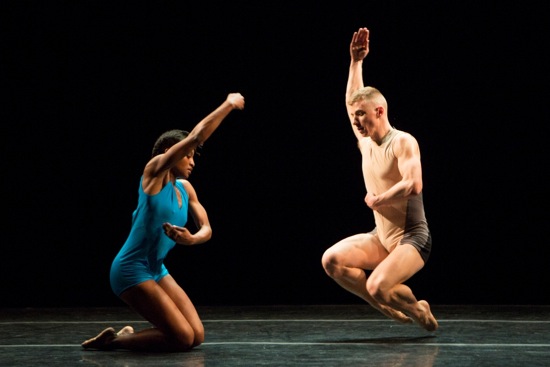
Davalois Fearon and Nicholas Sciscione in the new second part of Stephen Petronio’s
Locomotor/Non Locomotor. Photo: Yi-Chun Wu
There’s much less travelling in Non Locomotor, which begins after a short pause. Fearon tunes us in to the new slant on movement. She has changed out of her black, gray, and white outfit by Narciso Rodriguez into a bright blue one, and, while she may leap into action, she begins standing in one place and working her body as if forces inside it were migrating here and there, causing her spine to ripple, her shoulders to lift and circle, her hips to sway, her feet to jitter. The three men who spend time with her (Tuason, Grenek, and Sciscione) also investigate the ways in which their arms and hands can gesture, their heads can adjust on their necks, their hips can thrust forward.
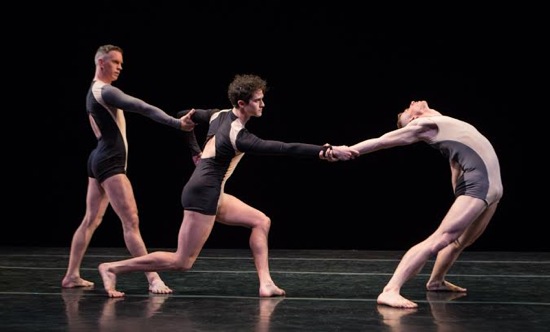
(L to R): Gino Grenek, Joshua Tuason, and Nicholas Sciscione in Stephen Petronio’s Non Locomotor. Photo: Yi-Chun Wu
They pose in sculptural ways, and Fearon, a blue streak, passes between them and among them. Although they lift her, she’s one of the gang. When the four of them divide into two couples, these drift in and out of synchrony as the paired dancers play catch and release or lean together. The four end Non Locomotor separated, bending forward and clapping their hands together—not as if they were applauding, but as if they were summoning some force out of the ground.
I recall Merce Cunningham once alluding to RainForest as being “about” a small community. I saw this ravishingly beautiful dance for a group of six around 1968 when it was new and again in the 1970s with a different cast (the premiere in Buffalo—where the company had a residency at SUNY-Buffalo and Buffalo State College—was filmed, and the later version appeared on television in 1976 for WNET’s Dance in America series). I did indeed see the six as forming a community, although one in which each of them was used to spending time alone. I thought of them as akin to a renegade pride of lions—with a leader, solitary hunters, interlopers, matings, and squabbles polished into a kind of mystical formality. Both David Vaughan in his masterly book Merce Cunningham: Fifty Years and Carolyn Brown in her marvelous Chance and Circumstance bring up the possible influence of nature on RainForest. One inspiration may have been Colin Turnbull’s The Forest People about the pygmies and their treks through jungles of impeding branches (which Cunningham was reading at the time). The rain forests of the Pacific Northwest, where he was raised, may also have fed into the dance.
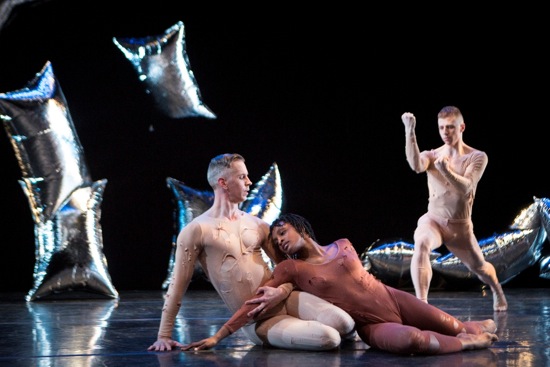
Nicholas Sciscione (R) approaching Gino Grenek and Davalois Fearon in Merce Cunningham’s RainForest. Photo: Yi-Chun Wu
Its setting by Andy Warhol is a host of silver mylar pillows. Filled with helium, they gleam in Aaron Copp’s lighting like pools of water struck by sun. A few are anchored above the stage, but others float at will (during the April 8th performance, five or more of them drifted out into the audience—a little too distractingly), and the dancers, in the course of their movements, kick them around. I recall David Tudor’s score, titled Rainforest, as evoking bird calls, rushing water, and other sounds of nature, albeit in disguise. On the night I attended, John Driscoll and Phil Edelstein mixed and produced the music on their consoles, and it seemed louder than I remembered but also wonderfully atmospheric. The costumes, devised by artist Jasper Johns, are flesh-colored leotards and tights that have had pieces cut out of them (they resemble a subtly mangy pelt).
RainForest is a rarity among Cunningham’s dances. It almost encourages you to interpret what you see as little dramas (as I have done above). Its ambiance is one that juxtaposes solitary ventures to unusual encounters that hover on the edges of “meaning.” The first sequence between Grenek (in Cunningham’s role) and Fearon (who alternates in the part created by Barbara Lloyd, aka Barbara Dilley, with Medlock) has an almost languorous quality. When he sits, she slowly crawls on her belly over and around him; he calmly presides over her journey, sliding one hand along the floor as she comes from behind him, so as to make an arch that she must pass through and turning his head to watch her do that. The arduousness of this mysterious task—which they repeat several times —is reinforced by its culmination: she lies draped across his lap, while a newcomer (Sciscione)—who has from the beginning been standing motionless, his back to the audience—advances deliberately on them, creating an odd counterpoint among his footsteps, the jerk of his arms into squared-off positions, and the sudden isolated contraction of his spine.
Cunningham wonderfully combined animalistic images with the elegance that is also intrinsic to him. When Grenek has exited, and Fearon has fallen on top of Sciscione, Tuason persistently nudges her off her prone partner with his head and shoulder, but then he and Sciscione advance on Fearon in slow lockstep, one of them making only a gentle hint of “go away “ with his hands; that gesture causes her to roll offstage. Later, Fearon stands with one leg lifted behind her, as poised as any ballet dancer, and Grenek crawls around her on his hands and knees, like an animal tracking a scent.
The sound of the dancers’ feet smacking the pillows as they stride about, often on tiptoe, plus the pillows’ evasive responses intensify the performers’ need for of alertness in an unpredictable landscape. And violence does erupt—not exactly as animosity, but as speed and physical recklessness. It’s almost a shock when Melissa Toogood (in a role that Brown, for whom it was created, characterized in her book as “spitfire, hellcat—feral and dangerous.”) cuts loose. Her long hair whips wildly when she and Sciscione whale their arms at each other and when he lifts her and flails her around him, sets her down, flails her around again, making her legs fan open each time. Later, she runs at him, and he upends her—her knees clamped over his shoulder—and swings her dangerously. You watch this, or Stone in her last-minute appearance shaking her head crazily, or Grenek in the final burst of furious movement that brings the curtain down, and wonder—not for the first time—what was going through Cunningham’s mind when he choreographed this unforgettable work of art and selected the visual and aural landscape in which it abides.
Toogood, as you’d expect, performs RainForest superbly. The others, who have obviously worked hard to master this new-to-them language, and have all the skill and intelligence needed to do so, will, I expect hone their performances over time. Fine as they are, they’re not yet fully fledged in this dance’s combination of precision (mainly in the swift, stiff, striding steps and certain gestures) with wildness (mostly in the arms and body and some of the “big” movements). The alertness to the moment, the full awareness of shifts in focus and dynamics. . .these they have only intermittently. Full immersion will surely come.
Meanwhile I applaud Petronio’s Bloodlines project and the combination of humility and confidence that made him decide to embark on it.

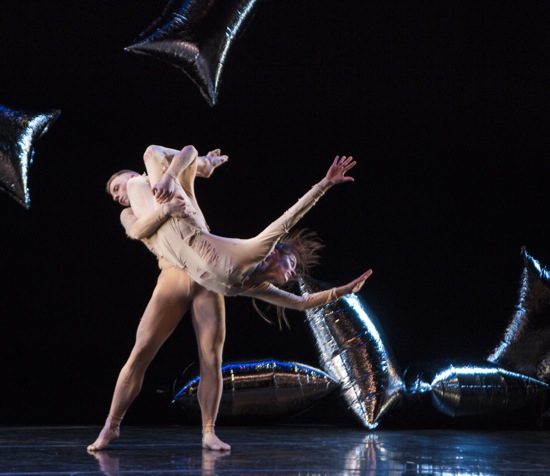
Hello,
My name is Davalois Fearon, Education Coordinator/senior dancer for the Stephen Petronio Company. I just recently started following reviews and would like to thank you for all the kind words you wrote about me and my dancing in this and past articles. It is truly appreciated!
Best,
Dava